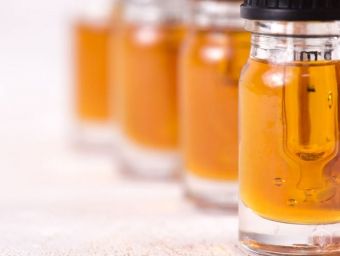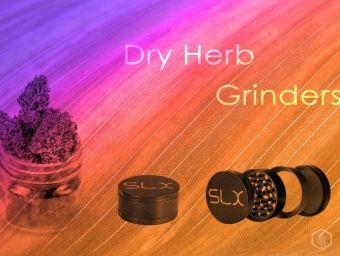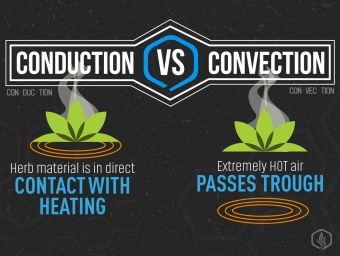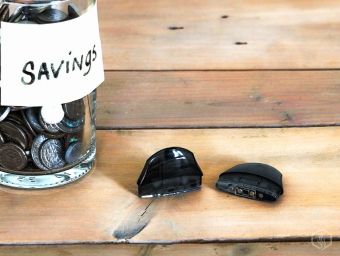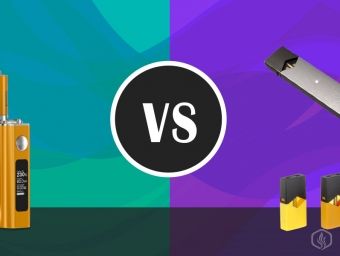I often get asked by readers stuff like - 'What's the proper way of setting up and RDA, and RBA base or an RTA? Is there a method to prevent dry hits? and What wire gauge is best for certain builds? – so this is why I decided to work on this coiling and wicking tutorial intended mainly for beginners in order to shed some light on the matter.
What are coils and what are the differences?
The first thing you need to understand is that all of the e-cigs and mods out there work on the same principle. Electricity from the battery reaches the atomizer where it runs through the coils thus generating heat. This heat vaporizes the e-liquid in the wicking material and generates the nicotine infused clouds we all love to puff on. This is basically what e-smoking consists of and the process is similar whether you're vaping on pre-built coil heads or on hand made alternatives.
 In any pre-built atomizer head we have one or two parallel or perpendicular coils which are usually surrounded by a layer of organic cotton. The cotton (or wicking material) is in direct contact with the feeding holes drilled on the exterior shell of the heads and therefore each time you fill up your tank with e-liquid it slowly reaches the resistances.
In any pre-built atomizer head we have one or two parallel or perpendicular coils which are usually surrounded by a layer of organic cotton. The cotton (or wicking material) is in direct contact with the feeding holes drilled on the exterior shell of the heads and therefore each time you fill up your tank with e-liquid it slowly reaches the resistances.
These pre-built coils are designed to offer a good flavor and a great amount of vapor, however they can't last forever and are usually tossed after one, two or even three weeks, depending both on the manufacturing technique and on your vaping style. Of course, there are some cases where inventive people come up with a way of re-building these capsulated coils, but just like in the case of refilling your printer cartridges, the results are not often as satisfying and don't last for too long.
How to wick a coil properly
So if you're tired of spending money on coils, there is an alternative called DIY coiling and wicking but you will need the proper device, the proper tools and knowledge in order to make your own builds. There are essentially three types of devices that work with user made coils – RDAs or rebuildable dripping atomizers, RTAs or rebuildable tank atomizers and regular tanks that come with an RBA base. An example of a rebuildable dripping atomizer is the vBit RDA, an example of a rebuildable tank atomizer is the brand new Kayfun Mini V3 and a well-known tank that comes with an RBA base is the Subtank Mini V2.
you will need the proper device, the proper tools and knowledge in order to make your own builds. There are essentially three types of devices that work with user made coils – RDAs or rebuildable dripping atomizers, RTAs or rebuildable tank atomizers and regular tanks that come with an RBA base. An example of a rebuildable dripping atomizer is the vBit RDA, an example of a rebuildable tank atomizer is the brand new Kayfun Mini V3 and a well-known tank that comes with an RBA base is the Subtank Mini V2.
What you need to know about wicking wires
Also you need to understand a bit about the wires we use in vaping and Kanthal is by far the most popular. It's an alternative to Nichrome, which was initially used in the industry and it's quite accessible and easy to find. For temperature control mod you can also use wire like Titanium, Nickel and Stainless Steel.
 Wires usually come packed in spools and each spool is characterized by a gauge and a length. Kanthal gauges (or AWG – American Wire Gauge) range from 20 to 38, but the most commonly used are 26, 28 and 30. These have the necessary resistances per inch to make them very popular for regular builds on RDAs, RTAs and Tanks.
Wires usually come packed in spools and each spool is characterized by a gauge and a length. Kanthal gauges (or AWG – American Wire Gauge) range from 20 to 38, but the most commonly used are 26, 28 and 30. These have the necessary resistances per inch to make them very popular for regular builds on RDAs, RTAs and Tanks.
Coiling accessories you will need
Making a coil is not rocket science and it basically implies wrapping the wire around a thin tubular body like a drill bit, screwdriver or coiling accessory. The number of wraps will give you the end resistance of the coil, depending on the AWG and the diameter of the drill bit. There are various online calculators and even smartphone apps which can help you get an estimate of the final resistance. As an example you will need six wraps of 28 AWG Kanthal on a 2mm drill bit to have a final resistance of 1.0 Ohms.
Cutting and wrapping the coils
In order to wrap a coil you must cut a piece of wire from the spool about 6 inches long, leave a 1 inch  lead and start going round the drill bit 6-8 times. The leads don't have to be equal in length and it's usually good to have one longer than the other. You then need to compress the coil while it's on the drill bit with your fingers and then take it off. Sometimes Kanthal can be a bit springy and hard to work with and in order to make it more malleable you simply need to torch it with your lighter for a few seconds before starting to wrap it. This is not always necessary and if you buy a coiling tool it's going to make things a lot easier as these accessories are specifically designed to craft perfect coils every time.
lead and start going round the drill bit 6-8 times. The leads don't have to be equal in length and it's usually good to have one longer than the other. You then need to compress the coil while it's on the drill bit with your fingers and then take it off. Sometimes Kanthal can be a bit springy and hard to work with and in order to make it more malleable you simply need to torch it with your lighter for a few seconds before starting to wrap it. This is not always necessary and if you buy a coiling tool it's going to make things a lot easier as these accessories are specifically designed to craft perfect coils every time.
Now that you know how to wrap a coil, it's time to check out the various atomizers. Rebuildable dripping atomizers or RDA tend to differ in terms of design, airflow and number of posts but they all work in essentially the same way. There are two or four negative posts on the outer deck and usually a single positive post (with single or double holes for the wire). The user has to connect each coil with one lead to the positive post and the other lead to any of the negative posts before tightening the screws and fixing it in place. On a standard RDA you can connect anything from one to four coils simultaneously but, with some exceptions.
 If you want to use more than one coil, then the rest of the coils need to be of exactly the same number of wraps as the initial one and their end resistance is going to be the initial coil resistance divided by the number of coils. For example if we have a 1.2 Ohm coil and use only one in an RDA, the final resistance of the RDA is going to be of 1.2 Ohms. However if we decide to go for a dual coil configuration and use two of the same coils, the final resistance is going to be 1.2/2 => 0.6 Ohms. On a quad coil configuration (four coils of the same type) the final resistance will be 1.2/4 = 0.3 Ohms. Always be careful if you battery can handle the low resistance and make sure to also read my article on general e-cigarette safety tips before starting building your own coils.
If you want to use more than one coil, then the rest of the coils need to be of exactly the same number of wraps as the initial one and their end resistance is going to be the initial coil resistance divided by the number of coils. For example if we have a 1.2 Ohm coil and use only one in an RDA, the final resistance of the RDA is going to be of 1.2 Ohms. However if we decide to go for a dual coil configuration and use two of the same coils, the final resistance is going to be 1.2/2 => 0.6 Ohms. On a quad coil configuration (four coils of the same type) the final resistance will be 1.2/4 = 0.3 Ohms. Always be careful if you battery can handle the low resistance and make sure to also read my article on general e-cigarette safety tips before starting building your own coils.
Testing your brand new DIY coil
After you're done fixing the coils in the posts we need to mount the RDA to the mod and start pulsating by pressing and releasing the firing button in consecutive moves. The aim here is having a coil that gets red from the interior and gradually reaches the extremities. If this does not happen you will need to use a pair of ceramic tweezers to squeeze the coil until you're satisfied with the result. If you don't have ceramic tweezers then you can also use a metallic one, just make sure you're not pressing the firing button when squeezing as it can cause a short circuit.
by pressing and releasing the firing button in consecutive moves. The aim here is having a coil that gets red from the interior and gradually reaches the extremities. If this does not happen you will need to use a pair of ceramic tweezers to squeeze the coil until you're satisfied with the result. If you don't have ceramic tweezers then you can also use a metallic one, just make sure you're not pressing the firing button when squeezing as it can cause a short circuit.
Organic cotton wicking material is recommended
 The next step would be to insert the wicking material and for this I recommend using organic cotton. These usually come in sheets and you will need to cut a half inch strip before removing the first thin layers (on one or both sides) which are a bit more rigid than the stuff on the inside. You then simply roll the cotton for a bit then take one of the ends and firmly rub it to make it pass through your coil. When the cotton passes the coil it needs to have a bit of resistance but at the same time it doesn't have to be so compact that it pulls the coil with it. After a few trial and error tries you'll be able to master this technique and then look for other wicking methods that are best suited for RDAs like the 'Scottish Roll'.
The next step would be to insert the wicking material and for this I recommend using organic cotton. These usually come in sheets and you will need to cut a half inch strip before removing the first thin layers (on one or both sides) which are a bit more rigid than the stuff on the inside. You then simply roll the cotton for a bit then take one of the ends and firmly rub it to make it pass through your coil. When the cotton passes the coil it needs to have a bit of resistance but at the same time it doesn't have to be so compact that it pulls the coil with it. After a few trial and error tries you'll be able to master this technique and then look for other wicking methods that are best suited for RDAs like the 'Scottish Roll'.
You then need to cut the ends of the cotton and leave around half an inch sticking out of each side  of the resistance. After that it's time to tug the cotton in the RDA juice well just under the coils and using some e-liquid to saturate the wicking material. You need to do this one, two, or four times, depending on the number of coils you're using. I definitely suggest starting with one and then gradually make the transition for dual coil configurations after a few weeks.
of the resistance. After that it's time to tug the cotton in the RDA juice well just under the coils and using some e-liquid to saturate the wicking material. You need to do this one, two, or four times, depending on the number of coils you're using. I definitely suggest starting with one and then gradually make the transition for dual coil configurations after a few weeks.
Saturate the cotton
After the wicking material has been mounted you can use the e-liquid bottle or dropper and fully saturate the cotton with e-liquid before pressing on the firing button. It should start generating vapor in no time and this means you're ready to go. Just mount the top cap on and start puffing on your first hand made coil.
 Just remember that RDAs require constant dripping of e-liquid and a few drops are good for anywhere between 5 to 10 puffs (depending on the number of coils and their resistance). If you start feeling the cotton getting dry make sure you pour some e-liquid before taking a nasty dry hit. Techniques like the 'Scottish Fold' can help improve the autonomy with a great number of extra puffs.
Just remember that RDAs require constant dripping of e-liquid and a few drops are good for anywhere between 5 to 10 puffs (depending on the number of coils and their resistance). If you start feeling the cotton getting dry make sure you pour some e-liquid before taking a nasty dry hit. Techniques like the 'Scottish Fold' can help improve the autonomy with a great number of extra puffs.
TIP: If you would like to purchase a beginner we suggest you to check out the best box mods for beginners section here.
You can make the coil the same way as in the case of an RDA but because of the narrow space it's going to be trickier to mount (but not impossible). One you mount your coil you need to connect the base to your mod and start pulsating. We are looking for the same pattern of the heating going from the center to the outer edges of the coil. Once you're satisfied with the result it's time to mount the cotton, exactly the same as in the case of the RDA, but with a small twist.
 Any RBA base or RTA base will usually have a tube that goes around the posts and we also have some small channels carved in the deck through which the e-liquid reaches the coil. In this case the wicking material needs to be cut exactly where it meets these channels and it takes a little bit of practice. To do this you will need to fold the cotton and make a marking right as it reaches the edge before cutting it. After that you simply use some e-liquid to carefully saturate de cotton and to place it exactly above the channels. Then it's time to test if it produces vapor, and after that you will need to assemble the tank.
Any RBA base or RTA base will usually have a tube that goes around the posts and we also have some small channels carved in the deck through which the e-liquid reaches the coil. In this case the wicking material needs to be cut exactly where it meets these channels and it takes a little bit of practice. To do this you will need to fold the cotton and make a marking right as it reaches the edge before cutting it. After that you simply use some e-liquid to carefully saturate de cotton and to place it exactly above the channels. Then it's time to test if it produces vapor, and after that you will need to assemble the tank.
Bubbles are good
As you start vaping you should see tiny bubbles forming at the base of the RTA or tank and this means the atomizer is wicking properly. If this doesn't happen and you start experiencing constant burnt taste you will need to re-do the wicking and use a bit less cotton this time or make sure you don't completely cover the juice feeding channels.
These tips should cover the basics on coiling and wicking but if you have any extra questions please contact me and I will gladly help you out.




